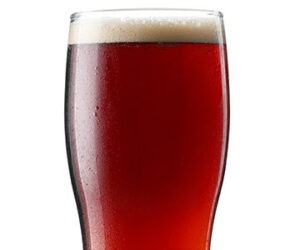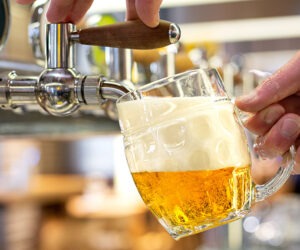Munich Dark Lager
At one time probably all the beers of Munich were dark lagers. Prior to modern malting technology, maltsters kilned their malt by allowing the hot fumes from burning wood or coal to pass directly through the bed of grain. The maltster had little control over the degree of roasting the malt received.
Consequently the malt produced was dark and flavored with the fuel used in the kiln. Inferior breeds of barley with high protein contents also contributed to the darkening of the malt. Of course dark malt begets dark beer. Dark lager remained the staple of Bavaria until the early 1900s, when advancements in malting technology made pale malt widely available.
Today, Munich dark lager, or Münchner Dunkel as the Germans say, still holds a special place in the Bavarian’s stein. Beyond pale malt, specialty grains used in this reddish-amber brew may include Munich, crystal, and a touch of roasted malts. Many German breweries export dunkel to the United States. Versions are available from Hacker-Pschorr, Ayinger, and Spaten. In general these beers have a malty-sweet nose with a touch of bready roastiness. The body is medium-sweet and lingers on the palate. An obviously low hopping rate is evident in the subdued bitterness and absence of aroma.
Because most imported beers will be tainted by oxidation, the pursuit of local interpretations is worthwhile. Look to microbreweries that specialize in German lagers for a taste of fresh dunkel. Freshly brewed dunkels can be hard to find. Another famous dark beer, Oktoberfest Märzen, tends to supplant efforts to popularize dunkel by outselling it. Still some examples of the style persist. Dixie Blackened VooDoo Lager fairly represents the Munich dark lager style as do dunkels from Gordon Biersch, Thomas Kemper, and California’s Sudwerk Brauerei.
Recipes for Munich dark lager have some variations, but most will produce an amber-colored lager that is big in malt, low in bitterness, and slightly roasted. For most versions malt types and percentages by weight fall into the following ranges: 35 percent to 62 percent pale malt, 21 percent to 38 percent Munich malt, 6 percent to 15 percent crystal malt (17° to 80° Lovibond), 0 to 5 percent roasted malt (usually chocolate). A small amount of wheat, 1 percent to 3 percent, in place of pale malt will help beer head retention without significantly impacting flavor. The bitterness falls in the range of 15 to 28 IBUs. Hop aroma should be subtle or nonexistent. Noble hop varieties such as Tettnanger, Hallertauer, and Saaz are appropriate. The brew starts with a gravity between 1.052 and 1.056 and ends with a gravity between 1.014 and 1.018 and an alcohol range of 4.5 percent to 5 percent by volume. At 17 to 23 SRM (standard reference method), the color is amber to deep red.
As with any dark German brew, a decoction mash is preferred. The reactions that occur when the mash is boiled contribute to the deep color and malty character of the beer. However, temperature program and infusion mashing methods can still make fine dunkels. An extended rest at a higher conversion temperature, 155° F, will favor the enzymatic formation of dextrins. This will tend to sweeten the beer and increase body.
Fruitiness and diacetyl do not belong in a Munich dark lager. Managing the fermentation and aging carefully will help avoid such flavors. German lager yeast of the Munich and Bavarian types are a good choice. The beer should be at a temperature between 50° and 60° F when the yeast is pitched. The temperature is lowered to 46° to 50° F as the fermentation starts. After fermentation allow the temperature to rise to 55° F for a couple days for a diacetyl rest.
Following fermentation the beer should be aged cold for at least a month before it is consumed. This period of cold storage, called lagering, will allow the beer to mature and helps drop out yeast.
Off-flavors such as sulfur, acetaldehyde, and diacetyl will decrease as the beer ages. After lagering is complete, sit back and down a much-deserved liter of dunkel.
Slam Dunkel
(5 gallons, all-grain)
This all-malt version of traditional Munich dunkel derives its color and flavor from five malts. Rich and malty yet entirely drinkable, this brew will keep the crowd cheering for more.
Ingredients:
• 4.5 lbs. pale two-row malt
• 3 lbs. Munich malt
• 1 lb. crystal malt, 60° Lovibond
• 0.5 lb. crystal malt, 20° Lovibond
• 0.25 lb. chocolate malt
• 2 oz. Tettnanger hops (4% alpha acid), 1.2 oz. at 60 min., 0.8 oz. at 30 min.
• Munich or Bavarian lager yeast
Step by Step:
For a temperature program mash, dough room-temperature grains into 3 gals. of 140° F mash water to reach a temperature of 132° F. Hold for 15 minutes. Then raise temperature two degrees per minute to 155° F and hold for 45 minutes. Raise temperature to 165° F. Sparge with 168° F water to collect six gallons of wort.
Boil for 30 minutes, then make the first hop addition. After another 30 minutes of boil, add the next measure of hops. Boil for another 30 minutes to make a total 90-minute boil. Cool and aerate wort, rack into a carboy, and add yeast at 60° F. Hold until start of fermentation, then slowly chill to 50° F. Hold for the remainder of fermentation.
After fermentation allow temperature to rise to 55° F for two days. Then cool to coldest refrigerator temperature and lager for four weeks. Package as desired and enjoy.
OG = 1.052 FG = 1.014 to 1.018
Slam Dunkel
(5 gallons, partial mash)
Ingredients:
• 3 lbs. pale malt extract
• 1.5 lbs. pale two-row malt
• 3 lbs. Munich malt
• 1 lb. crystal malt, 60° Lovibond
• 0.5 lb. crystal malt, 20° Lovibond
• 0.25 lb. chocolate malt
• 2 oz. Tettnanger hops (4% alpha acid), 1.2 oz. at 60 min., 0.8 oz. at 30 min.
• Munich or Bavarian lager yeast
Step by Step:
For a temperature program mash, dough room-temperature grains into 2 gals. of 140° F mash water to reach 132° F. Hold for 15 minutes, then raise two degrees per minute to 155° F and hold for 45 minutes. Raise temperature to 165° F. Sparge with 168° F water to collect 4 gals. of wort. Add 1.5 gals. of water, 4 gals. hot wort, and malt extract into kettle. Heat to boil while mixing in extract.
From the start of boil, follow the remainder of the step by step from the all-grain version of Slam Dunkel.
OG = 1.052 FG = 1.014 1.018
My First Dunkel
(5 gallons, extract with specialty grains)
My First Dunkel is an all-extract brew that takes advantage of the many dark malt extracts available. This recipe is easy to brew and just as easy going down.
Ingredients:
• 7.5 lbs. dark malt extract
• 1 lb. crystal malt, 20° Lovibond
• 2 oz. Tettnanger hops (4% alpha),
1.2 oz. at 60 min., 0.8 oz. at 30 min.
• Munich or Bavarian lager yeast
Step by Step:
Pour crushed grains into nylon mesh bag. Steep in 2 gals. water at 150° F for 15 minutes. Meanwhile, heat 2 gals. of water separately to 150° F. Remove grain bag and place in colander or strainer. Place colander over kettle. Pour hot water through grains in colander. When finished, the kettle should contain 4 gals. of grain-tinged water. Stir in malt extract while heating kettle to boil. As soon as boil starts, add hops. Add remaining hops 30 minutes later. Total boil is one hour.
From the end of boil, follow the remainder of the step by step from the all-grain version of Slam Dunkel.
OG = 1.052 FG = 1.010 to 1.015



